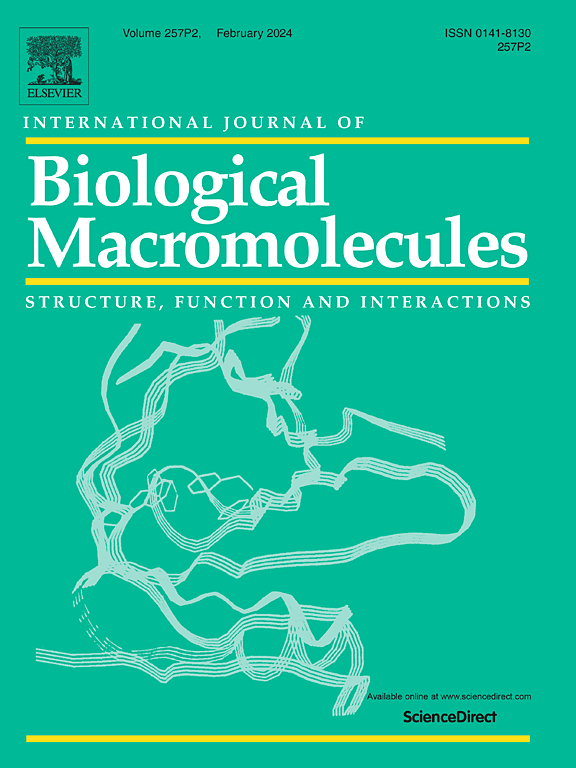天然多糖聚合物抗膨胀水凝胶:新型水下可穿戴运动传感器核心材料
IF 8.5
1区 化学
Q1 BIOCHEMISTRY & MOLECULAR BIOLOGY
International Journal of Biological Macromolecules
Pub Date : 2025-08-20
DOI:10.1016/j.ijbiomac.2025.147002
引用次数: 0
摘要
由于可穿戴电子设备和软机器人技术的快速发展,抗膨胀水凝胶因其在水环境下的优异稳定性而引起了人们对水下运动传感的极大兴趣。本文首先对用于抗膨胀水凝胶工程的基于多糖的构建块进行了分类,然后系统地讨论了结构设计策略,并回顾了它们在运动传感中的应用的最新进展。本文首先综述了壳聚糖和海藻酸钠等天然多糖制备抗膨胀水凝胶的研究进展。随后,三种关键的构建策略被严格检查:(i)基于膨胀平衡理论的分子工程,以非共价交联为例;(ii)通过双分子或超分子网络进行分层网络调节;(三)由皮肤样结构启发的仿生策略。最后,系统地比较了传统方法(如纳米纤维增强)和新兴技术之间的协同作用。这些水凝胶同时保持高含水量,具有优异的机械坚固性、导电性和生物相容性,使其成为可穿戴水下运动传感器的理想选择。然而,关键的挑战——包括在水环境下的长期稳定性、可扩展的制造和经济可行性——仍未解决。因此,未来的研究必须优先考虑合理设计多功能水凝胶,以满足不断升级的工业和临床需求。本文章由计算机程序翻译,如有差异,请以英文原文为准。
Review anti-swelling hydrogels from natural polysaccharide polymers: Emerging core materials for underwater wearable motion sensors
Owing to the rapid advancement of wearable electronics and soft robotics, anti-swelling hydrogels have attracted considerable interest for underwater motion sensing because of their outstanding stability under aqueous conditions. Herein, this review first catalogues polysaccharide-based building blocks employed to engineer anti-swelling hydrogels, then systematically discuss structural design strategies and review recent advances in their application to motion sensing. This review first summarizes the use of natural polysaccharides—including chitosan and sodium alginate—for preparing anti-swelling hydrogels. Subsequently, three pivotal construction strategies are critically examined: (i) molecular engineering grounded in swelling-equilibrium theory, exemplified by non-covalent cross-linking; (ii) hierarchical network regulation via dual or supramolecular networks; and (iii) biomimetic strategies inspired by skin-like structures. Finally, the synergistic interplay between conventional approaches (e.g., nanofiber reinforcement) and emerging technologies is systematically compared. These hydrogels simultaneously retain high water content and exhibit superior mechanical robustness, electrical conductivity, and biocompatibility, rendering them ideal candidates for wearable underwater motion sensors. Nevertheless, critical challenges—including long-term stability under aqueous conditions, scalable manufacturing, and economic viability—remain unresolved. Future investigations must therefore prioritize the rational design of multifunctional hydrogels that satisfy escalating industrial and clinical requirements.
求助全文
通过发布文献求助,成功后即可免费获取论文全文。
去求助
来源期刊
CiteScore
13.70
自引率
9.80%
发文量
2728
审稿时长
64 days
期刊介绍:
The International Journal of Biological Macromolecules is a well-established international journal dedicated to research on the chemical and biological aspects of natural macromolecules. Focusing on proteins, macromolecular carbohydrates, glycoproteins, proteoglycans, lignins, biological poly-acids, and nucleic acids, the journal presents the latest findings in molecular structure, properties, biological activities, interactions, modifications, and functional properties. Papers must offer new and novel insights, encompassing related model systems, structural conformational studies, theoretical developments, and analytical techniques. Each paper is required to primarily focus on at least one named biological macromolecule, reflected in the title, abstract, and text.

 求助内容:
求助内容: 应助结果提醒方式:
应助结果提醒方式:


